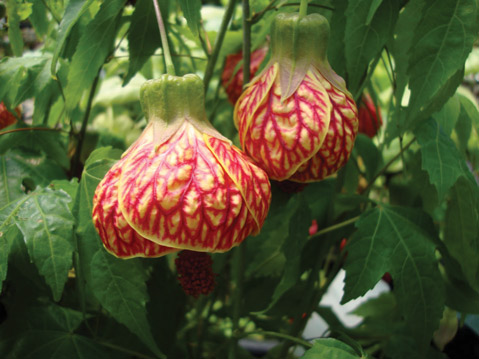Marvelous Mallows
Pretty Flowers and Pest Reduction

The mallow family, malvaceae, has several thousand species, and the botanists are not quite done deciding just what belongs in this group. There are several very well known genera. Some, such as Sterculia (monkey hand tree is probably the least common but truly fascinating and a subject for another day), Dombeya (most species planted locally have many very small flowers in clusters that have led to names like strawberry snowball tree and pink ball tree), and others are woody shrubs or impressive trees. But there are some more modest members of this cosmopolitan family that will fit into many landscapes. Among them are hibiscus and hollyhocks, both old-timey favorites from Grandma’s garden. Hibiscus cultivars grow well in South California, and the woody shrubs can thrive for decades but can also be prone to the dreaded giant whitefly. Hollyhocks, for some reason, have fallen out of favor, but their towering spires of colorful flowers can add plenty of interest to gardens, still. Some other relatives of these showy flowering species are less well-known.
Two shrubby ones are making some headway in the landscape trade. Both of these are nearly ever-blooming in Southern California gardens. Chinese bellflower (a misnomer, as most are from Southern America) or flowering maple are two of the common names for some of the species and cultivars of the genus Abutilon. Their flowers could be likened to bell-shaped origami creations, with crinkled petals loosely wrapped around a dramatic conglomeration of pistils and stamens that have been twisted and fused together, rather showy in itself, at the heart of the flower. Abutilons are delightful shrubs that have divided leaves that are similar to maples, hence that common name, and the dangling flowers come in many shades, from pure white through yellow, coral, pink, and red.
Commonly called the blue hibiscus, Alyogyne huegelii is native to Australia. Its flowers have the same twirly shape, but in a more relaxed way. The five, vibrant lilac petals flare outward from a similarly seductive sexual center. As with all the members of this family, the flowers produce nectar and copious amounts of pollen, inviting visits from a wide variety of insect pollinators. The whole aspect of the blue hibiscus shrub is somewhat airy, as the leaves are divided into many lobes and crenulations and the stems branch rather sparsely. Periodic light pruning will encourage more branching and the resultant increase in flower production, as well as a fuller complement of foliage.
There is a California native with several selected cultivars to include in this rundown. Lavatera assurgentifolia, also known as malva rosa, is native along the coastal bluffs, including the Channel Islands. It happily grows in gardens a little farther north and even a little farther inland throughout Southern California. While it is an evergreen shrub, it has a relatively short lifespan, and some insects may find it tasty if it is grown in conditions that maximize off-season watering and fertilization that provides higher than its normal meager nutrient requirements. So starve it, and it should thrive!
The added bonus for any and all of these malvaceous beauties is that those prominent sex organs prove attractive and accessible to a wide range of insects. Many of these will provide other services in the garden as their offspring colonize and parasitize some of the worst garden pests, such as aphids and mealy bugs. Pretty flowers and pest reduction? What could be more perfect?



